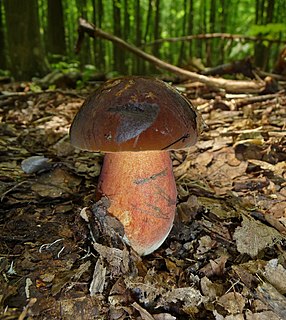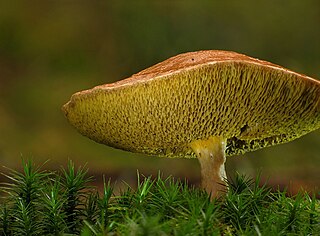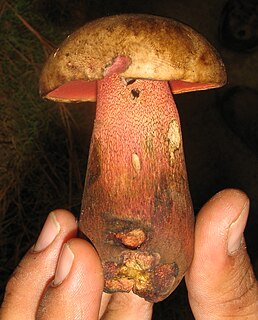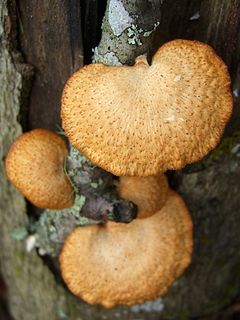Related Research Articles

Laetiporus sulphureus is a species of bracket fungus found in Europe and North America. Its common names are crab-of-the-woods, sulphur polypore, sulphur shelf, and chicken-of-the-woods. Its fruit bodies grow as striking golden-yellow shelf-like structures on tree trunks and branches. Old fruitbodies fade to pale beige or pale grey. The undersurface of the fruit body is made up of tubelike pores rather than gills.
Fomitopsis pinicola, is a stem decay fungus common on softwood and hardwood trees. Its conk is known as the red-belted conk. The species is common throughout temperate Europe and Asia, and Nova Scotia. It is a decay fungus that serves as a small-scale disturbance agent in coastal rainforest ecosystems. It influences stand structure and succession in temperate rainforests. It performs essential nutrient cycling functions in forests. It has been reported that mushrooms have significant antioxidant activity.

Suillus granulatus is a pored mushroom of the genus Suillus in the family Suillaceae. It is similar to the related S. luteus, but can be distinguished by its ringless stalk. Like S. luteus, it is an edible mushroom that often grows in a symbiosis (mycorrhiza) with pine. It has been commonly known as the weeping bolete, or the granulated bolete. Previously thought to exist in North America, that species has now been confirmed to be the rediscovered Suillus weaverae.

Neoboletus luridiformis, also previously known as Boletus luridiformis and (invalidly) as Boletus erythropus, is a fungus of the bolete family, all of which produce mushrooms with tubes and pores beneath their caps. It is found in Northern Europe and North America, and is commonly known as the scarletina bolete, for its red pores. Other common names is: red foot bolete, dotted stemmed bolete, dotted stem bolete.

Suillus bovinus, also known as the Jersey cow mushroom or bovine bolete, is a pored mushroom of the genus Suillus in the family Suillaceae. A common fungus native to Europe and Asia, it has been introduced to North America and Australia. It was initially described as Boletus bovinus by Carl Linnaeus in 1753, and given its current binomial name by Henri François Anne de Roussel in 1806. It is an edible mushroom, though not highly regarded.

Rubroboletus pulcherrimus—known as Boletus pulcherrimus until 2015—is a species of mushroom in the family Boletaceae. It is a large bolete from Western North America with distinguishing features that include a netted surface on the stem, a red to brown cap and stem color, and red pores that stain blue upon injury. Until 2005 this was the only bolete that has been implicated in the death of someone consuming it; a couple developed gastrointestinal symptoms in 1994 after eating this fungus with the husband succumbing. Autopsy revealed infarction of the midgut.

Polyporus alveolaris, commonly known as the hexagonal-pored polypore, is a species of fungus in the genus Polyporus. It causes a white rot of dead hardwoods. Found on sticks and decaying logs, its distinguishing features are its yellowish to orange scaly cap, and the hexagonal or diamond-shaped pores. It is widely distributed in North America, and also found in Asia, Australia, and Europe.

Gloeoporus is a genus of crust fungi in the family Irpicaceae. The genus has a widespread distribution.

Butyriboletus frostii, commonly known as Frost's bolete or the apple bolete, is a bolete fungus first described scientifically in 1874. A member of the family Boletaceae, the mushrooms produced by the fungus have tubes and pores instead of gills on the underside of their caps. Butyriboletus frostii is distributed in the eastern United States from Maine to Georgia, and in the southwest from Arizona extending south to Mexico and Costa Rica. A mycorrhizal species, its fruit bodies are typically found growing near hardwood trees, especially oak.

Tylopilus plumbeoviolaceus, commonly known as the violet-grey bolete, is a fungus of the bolete family. First described in 1936, the mushroom has a disjunct distribution, and is distributed in eastern North America and Korea. The fruit bodies of the fungus are violet when young, but fade into a chocolate brown color when mature. They are solid and relatively large—cap diameter up to 15 cm (5.9 in), with a white pore surface that later turns pink, and a white mycelium at the base of the stem. The mushroom is inedible. A number of natural products have been identified from the fruit bodies, including unique chemical derivatives of ergosterol, a fungal sterol.

Suillus pungens, commonly known as the pungent slippery jack or the pungent suillus, is a species of fungus in the genus Suillus. The fruit bodies of the fungus have slimy convex caps up to 14 cm (5.5 in) wide. The mushroom is characterized by the very distinct color changes that occur in the cap throughout development. Typically, the young cap is whitish, later becoming grayish-olive to reddish-brown or a mottled combination of these colors. The mushroom has a dotted stem (stipe) up to 7 cm (2.8 in) long, and 2 cm (0.8 in) thick. On the underside on the cap is the spore-bearing tissue consisting of minute vertically arranged tubes that appear as a surface of angular, yellowish pores. The presence of milky droplets on the pore surface of young individuals, especially in humid environments, is a characteristic feature of this species. S. pungens can usually be distinguished from other similar Suillus species by differences in distribution, odor and taste. The mushroom is considered edible, but not highly regarded.

Fomes fomentarius is a species of fungal plant pathogen found in Europe, Asia, Africa and North America. The species produces very large polypore fruit bodies which are shaped like a horse's hoof and vary in colour from a silvery grey to almost black, though they are normally brown. It grows on the side of various species of tree, which it infects through broken bark, causing rot. The species typically continues to live on trees long after they have died, changing from a parasite to a decomposer.

Boletus carminiporus is a species of bolete fungus in the family Boletaceae. Described as new to science in 1998, the species is found in the southern United States where it grows in a mycorrhizal association with various trees in mixed forests.

Hapalopilus rutilans is a species of polypore fungus in the family Polyporaceae. Officially described in 1821, it was transferred to its current genus Hapalopilus six decades later. It is commonly known as the tender nesting polypore, purple dye polypore, or the cinnamon bracket. This widely distributed species is found on five continents. It grows on the fallen or standing dead wood of deciduous trees, in which it fruits singly, in groups, fused, or in overlapping clusters. Fruit bodies are in the form of kidney-shaped to semicircular, cinnamon-orange-brown brackets. The underside of the fruit body features a yellowish to brownish pore surface with tiny angular pores, from which spores are released.

Buchwaldoboletus lignicola is a species of bolete fungus in the family Boletaceae native to Europe and North America. Found on wood, it is actually parasitic on the fungus Phaeolus schweinitzii. It has a convex yellow- to rusty brown cap, yellow to yellow-brown pores and stipe, and a brown spore print. Its edibility is unknown.

Pycnoporellus alboluteus, commonly known as the orange sponge polypore, is a species of polypore fungus in the family Fomitopsidaceae. Distributed throughout the boreal conifer zone, the fungus is found in mountainous regions of western North America, and in Europe. It causes a brown cubical rot of conifer wood, especially spruce, but also fir and poplar. The soft, spongy orange fruit bodies grow spread out on the surface of fallen logs. Mature specimens have tooth-like or jagged pore edges. A snowbank mushroom, P. alboluteus can often be found growing on logs or stumps protruding through melting snow. Although the edibility of the fungus and its usage for human culinary purposes are unknown, several species of beetles use the fungus as a food source.
Hapalopilus africanus is a species of polypore fungus. Found in Rwanda, it was described as new to science in 1978 by Norwegian mycologist Leif Ryvarden. The type collection was found growing on deciduous wood near Nyungwe Forest, close to Cyangugu. The crust-like fruitbodies are yellow with a chrome yellow pore surface. The pores and angular, thin-walled, and number about one to three per millimetre. Spores produced by the fungus are ellipsoid in shape, smooth, hyaline (translucent), measuring 4–5 by 2–2.4 μm.
Metuloidea murashkinskyi is a species of tooth fungus in the family Steccherinaceae. It is found in Europe and Asia, where it causes a white rot on the wood of deciduous trees.
Skeletocutis nothofagi is a rare species of poroid crust fungus in the family Polyporaceae that is found in South America. It has been proposed for inclusion in the IUCN Red List of Threatened Species due to its highly restricted distribution and rare occurrence.
Gloeoporus orientalis is a species of crust fungus in the family Irpicaceae. Found in East Asia, it was described as a new species in 2018 by Paul Jung and Young Wood Lim. The type collection was made in Geojedo, Korea, where it was found growing on a fallen angiosperm trunk.
References
- ↑ Jung, Paul Eunil; Lee, Hyun; Wu, Sheng-Hua; Hattori, Tsutomu; Tomšovský, Michal; Rajchenberg, Mario; Zhou, Meng; Lim, Young Woon (13 April 2018). "Revision of the taxonomic status of the genus Gloeoporus (Polyporales, Basidiomycota) reveals two new species". Mycological Progress. 17 (7): 855–863. doi:10.1007/s11557-018-1400-y. S2CID 4804695.